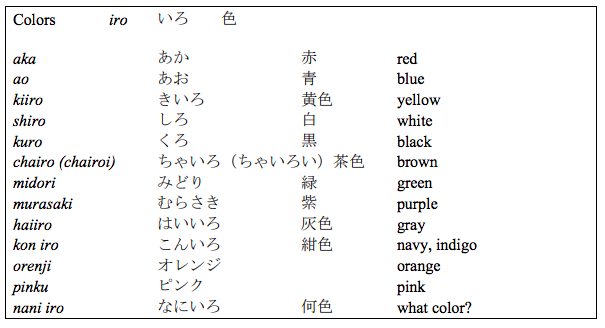1.4: Dialogue 4
- Page ID
- 31507
In a gift shop
Emily: Omiyage o kaimashita. I bought souvenirs.
お土産 みやげ を買 か いました。
Yamada: Waa, kawaii desu nee. Wow, cute!
わあ、かわいいですねえ。
Emily: Deshou? Aren’t they?
でしょう?
Yamada: Akai no wa kore dake desu ka. Is this all of the red ones?
赤 あか いのは、これだけですか。
Emily: Ie, mou ik-ko arimasu yo. Hora. No, there’s one more! Look.
いえ、もう一個いっこ ありますよ。ほら。
Vocabulary
omiyage おみやげ お土産 souvenir
kawaii かわいい cute
deshou でしょう? Don’t you think?
akai あかい 赤い red
akai no あかいの 赤いの red one(s)
dake だけ only, just
~ko 〜こ 個 classifier for small objects or pieces
ik-ko いっこ 一個 one piece, one item
mou ik-ko もういっこ もう一個 one more
+kakko ii かっこいい good-looking, stylish, cool
+aoi あおい 青い blue
+kiiroi きいろい 黄色い yellow
+shiroi しろい 白い white
+kuroi くろい 黒い black
+iro いろ 色 color
+nani iro なにいろ 何色 what color?

Grammar Notes
More classifiers : 〜個こ ,〜枚 まい ,〜冊 さつ
The classifier –ko is used for counting pieces or other units that are relatively small—everything from pieces of cake to apples to packets of sugar. The classifier –ko overlaps in many respects with –tsu. One difference is that –tsu can be used for abstract things like ideas, meetings, or items in a list, while –ko is used only for concrete items. Observe the following examples:
りんご二個 に こ ringo ni-ko or りんご二ふ た つ ringo futa-tsu two apples
お砂糖一個 さとういちこ osatou ik-ko or お砂糖 さとう 一 ひと つ osatou hito-tsu one packet/cube of sugar
会議 かいぎ が二 ふた つありました。Kaigi ga futa-tsu arimasita. There were two meeting.
The classifier for thin, flat objects is 〜枚ま い –mai and the classifier for bound volumes is - 〜冊さ つ –satsu. Note the sound changes with one, eight, and the question word.


Nouns and Adjectives
Some of the colors have both an adjective and a noun form, as shown in the list
above. Thus it is possible to say both aka desu and akai desu to mean ‘It’s red.’ Equally
the negative forms are aka ja nai desu and akaku nai desu. Which one to use largely
depends on the convention, while you can probably assume the noun versions indicate
classification rather than appearance or characteristics (aka for red wines and the red
light, for example.) All the color words borrowed from other languages are nouns, and
modify nouns with no:
ブルーのバッグ buruu no baggu blue bag
オレンジの紙 orenji no kami orange paper


